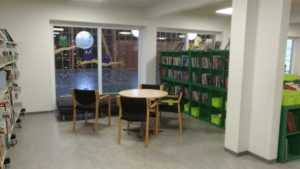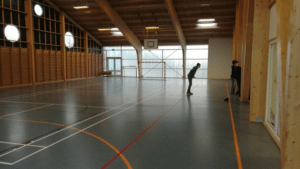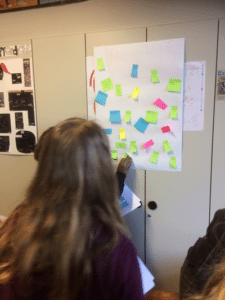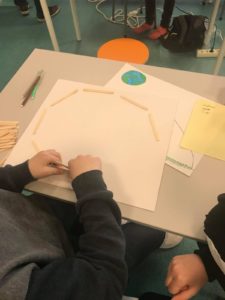Methodology
The sections below – Discover, Define, Develop and Deliver – align to the design thinking model:

Discover
Trigger
Prior to the project day, all four countries either filmed or took pictures of their school, including the playground, classroom, sports centre and library, and sent it to the other countries. On the project day, all classes took a look at the pictures to get inspiration when building the ideal school in space.



In the classes, we discussed what we liked about the other schools and talked about what we would like to bring to space.

Define
In the defining phase, we watched a video from the Falcon-X launch, considered the technological feats necessary for this launch, and discussed how it would be to live on Mars. Additionally, we watched a movie of how an astronaut makes his lunch in zero gravity.
Afterwards, the pupils started developing ideas of what kind of playground they would have there. We went outside and considered the playground, thinking about what makes these constructions fun and how would they work if there was no gravity.
The pupils started to develop ideas of what kind of playgrounds they could create on Mars or on a space station.
Different countries began to develop ideas for different spaces or rooms in the space school.
Develop
Each group decided on one project and created a model of their solution. There were many ideas in the different groups so the pupils had to discuss and come up with one common idea that they wanted to develop further.



Deliver
Each group presented their model and wrote a short text which explained how the model worked. They then photographed it or make a video to share (some using green screening).
Norway, Denmark, Belgium, England

International Collaboration
We emphasised the international collaboration by showing on Google Maps where the different schools in the other countries were, and that we were collaborating with those pupils. During the collaboration day each group would take a picture of their work (so far) and add a personalised message to send to their partner school in another country.
It was important to show that the pupils did an important job and that we very much appreciated their effort.
What was great about this project was that it emphasised the collaboration with the others countries. Each country created a different room for the space school. Norway built the playground, England built the library, Denmark built the hall/sports centre and Belgium built the classroom. So together everyone helped to build the ideal space school.
Resources Needed
- All kinds of handiwork equipment: glue, rope, wood, items from nature, cloth, plastic bags etc.
- Lego bricks
- iPads, computers, Smartboards
STEM to STEAM Analysis
Science: The pupils considered conditions in space such as gravity and atmosphere, and how those would affect us. What kind of technology would we need to overcome these conditions?
Technology: Google SketchUp or bridge constructing software that allows pupils to test the strength of different types of structures. With younger pupils you could use software such as GIMP or Tuxpaint to design the structures.
Engineering: The pupils have to systematically plan their solution before constructing it. While constructing the model rooms, the pupils have to consider how their constructions would actually work in real life. It would be a good idea to also include a manual to describe how each prototype is supposed to work.
Art: When producing the prototype environments, the pupils have to consider the aesthetic aspect. In order to be able to do this, pupils need to be given “good” material to work with (paint, cardboard, woodwork etc). The art aspect would also profit from giving pupils enough time to work on their models and experiment with and discuss alternative ideas.
Mathematics: It is important to measure and make the models in the correct scale. This could be accomplished by using apps such as SketchUp. The pupils can also experiment with different geometric shapes and in 2D and 2D dimensions.
Padlet – Ideas
Below is a Padlet of examples to help you to think about how you could develop this theme in your own teaching context.
You can open the Padlet in a new tab if you prefer: https://padlet.com/dlaberasmus/Unit1SeeingSTEAMWhatifwemovedtospace
After you have reviewed these materials click on Mark Complete at the bottom of this page to continue.
